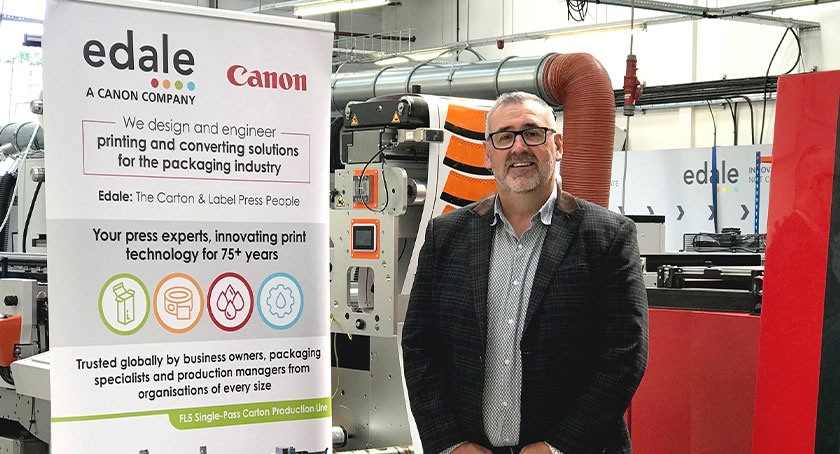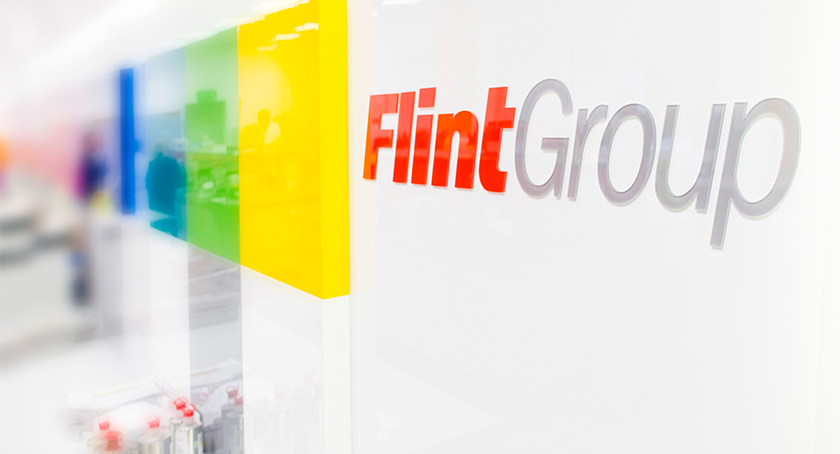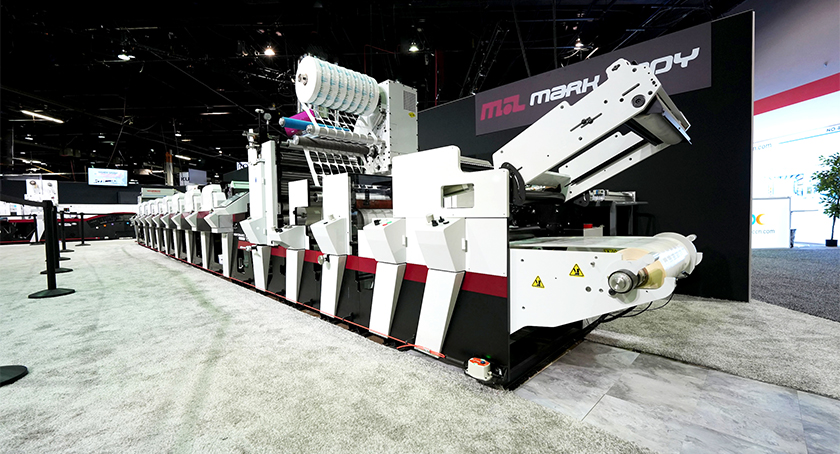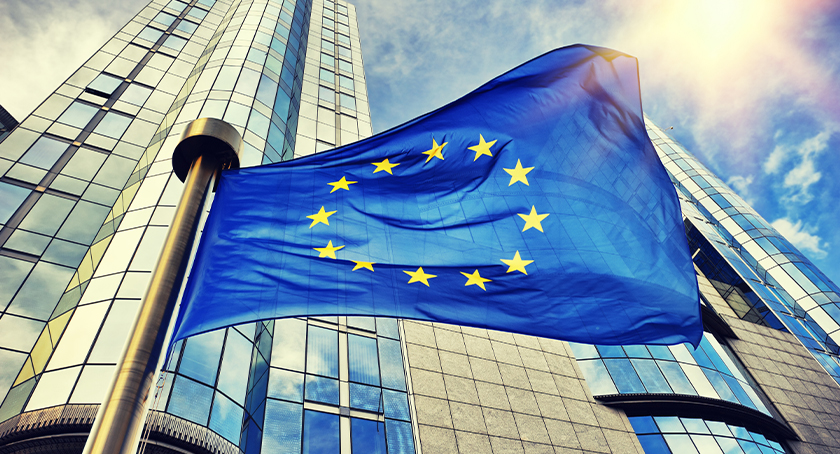As the industry heads across the pond for another edition of Labelexpo Europe, it’s important to address the latest trends impacting the sector. Europe has historically been recognized for its cutting-edge innovation and advancements in sustainability. In fact, many laud Europe for being 5-10 years ahead of North America when it comes to sustainability.
The challenges impacting the North American label market are very much present in Europe, too. For example, concerns about trade, tariffs, and supply chain health are just as prevalent. And they’re making an impact. “Global issues like the conflicts in Ukraine and the Middle East, coupled with inflation, have had an impact, as did the Covid pandemic,” remarks Timo Donati, European sales manager at Mark Andy. “The availability of electronic components became more difficult, and prices for raw materials like steel and electronics have increased significantly. These developments have affected investment planning and delivery times.”
“There’s no denying that supply chains have become a lot more unpredictable,” adds Lachlan Buirds, managing director, Edale, a Canon company. “Newly introduced tariffs have hit some converters, especially those in the food and cosmetics sectors who sell internationally. We’ve also noticed some internal friction within Europe. While the EU is pushing for aligned sustainability laws, different countries are interpreting and enforcing them in different ways. So, a label that’s compliant in one region might need changing for another, and that adds cost, time, and complexity.
“Volatility is certainly visible in the market, and this is visible in the supply chain of materials, customer buying behaviors, movement of goods and openness of certain markets,” adds Katja Kivelä, director, Business Growth & Advanced Label Solutions, EMEIA, UPM Adhesive Materials. “Consumers view brand owners and packaging producers as the most responsible for driving sustainability in packaging, as well. Sustainability, including decarbonization and circularity, has been driving the packaging and label value chain to data and science proved solutions.”
This technological shift is occurring alongside a heightened focus on regulatory issues, particularly among converters serving the food and beverage sector. According to Flint Group, the newest regulations are significant. “The introduction of the German Printing Ink Ordinance and similar regulations across Europe, for example, have heightened the industry’s focus on food contact material (FCM) inks,” states Anna Niewiadomska, marketing manager for Narrow Web and Label, Flint Group. “Printers and converters are seeking ever-greater assurance that their products meet the strictest safety standards, prompting a surge in demand for inks and coatings that are fully compliant and thoroughly tested. Our EkoCure ANCORA is specially formulated to address these requirements, providing peace of mind for customers working in sensitive product applications.
“The regulatory environment has become more stringent, particularly concerning food safety and product compliance,” she adds. “There is a pronounced emphasis on ensuring that labels and packaging meet the highest standards for consumer safety, with non-compliance simply not an option for brands and converters alike.”
In addition, industry consolidation is gaining speed, with larger conglomerates looking to expand their market presence and achieve greater economies of scale. This consolidation is intensifying competition and is increasing pressure throughout the supply chain.
“Against this backdrop, production optimization has become a central concern for our customers,” adds Niewiadomska. “There is a clear drive to enhance productivity and reduce waste, making our solutions especially relevant.”
From a supply chain perspective, selecting the right partners is key for success. Much of the global strife is having a direct impact on the ability to procure supplies and equipment.
“Global conflicts and ongoing trade disruptions have introduced complexity to the market, as well as barriers to effective supply chain management,” says Niewiadomska. “The origin and traceability of raw materials is subject to increased scrutiny as customers seek to mitigate risk and ensure continuity of supply, and this heightened focus on transparency is reshaping procurement strategies across the industry.”
“Global disruptions have increased raw material costs and extended lead times, forcing converters to optimize inventories and diversify sourcing,” adds Cleo Nomikos, president, INX Europe. “Energy price fluctuations in Europe have accelerated the move toward energy-efficient curing technologies like UV LED. These challenges have also strengthened the collaboration between suppliers and customers to ensure continuity and stability.”
 Edale’s Lachlan Buirds sees Europe as a “resilient” market.
Edale’s Lachlan Buirds sees Europe as a “resilient” market.Despite numerous challenges, optimism abounds for Mark Andy. “We remain optimistic,” says Donati. “Mark Andy has a strong structure in place and is well prepared for these challenges. In fact, we’re proud to say that we increased our market share in Europe during these difficult times, which shows the strength and reliability of our technology and support.”
“The European market has been incredibly resilient, more so than many people expected,” states Buirds. “Even with all the disruptions of the past few years, the European label market grew by 9.6% in 2024. A big driver has been growth in e-commerce and direct-to-consumer sales. We’ve seen more demand for everything, from track-and-trace solutions to custom, short-run labels. And with private label products growing in popularity, the number of SKUs is ballooning, which puts a lot of pressure on turnaround times.”
European R&D currently centers on more complex label applications. “Multi-layer constructions with three or more layers are increasingly in demand because of new regulations and the need to place more information on the label,” explains Donati. “There is also a clear rise in special applications like linerless labels and RFID solutions. Many customers ask for better solutions for variable data printing, especially with barcodes or QR codes. In general, print runs are getting shorter, and the number of different SKUs is increasing rapidly. This pushes the need for more flexible and efficient production technology.”
UPM honored in Dow Jones World and European Sustainability Indices
UPM has been listed as the only forest and paper industry company in the Dow Jones Global and European Sustainability Indices (DJSI) for the years 2024-2025. The indices cover environmental, social and governance aspects of responsibility.
“We are committed to creating value for our customers by using sustainable, renewable resources, reducing our environmental footprint, and increasing our positive societal impact. Sustainability is a core strategic value for UPM,” says Sami Lundgren, vice president, Responsibility at UPM.
This commitment is strongly visible in the company’s recently updated strategy. UPM’s business portfolio is based on sustainable feedstocks and fossil-free energy, positioning the company for growth in renewable fibers, advanced materials, and decarbonization solutions, while graphic papers continue to generate strong cash flows.
UPM has also successfully issued a new EUR 600 million Green Bond in 2024 under its Green Finance Framework. With the fourth issuance, UPM has further strengthened its position as one of the largest corporate Green Bond issuers in the Nordics, with a total of EUR 2,350 million issued.
As far as equipment goes, flexo remains a top printing technology in Europe. According to Mark Andy, flexo is still a very strong and important technology in the European market. Many converters still rely on flexo presses, especially for long runs, specialty finishes, and demanding substrates. Plus, web widths are also increasing, with more customers now investing in wider machines – 17″ and more.
Quality is also paramount. Brands are becoming more discerning than ever, requiring labels that stand out on crowded shelves. “There’s a big premiumization push, especially in sectors like cosmetics, drinks, and high-end food,” adds Buirds. “Brands are looking for more texture, more embellishment, and more standout labels, which means label converters need inline finishing and HD flexo to keep up.”
 Flint Group cites an increasing focus on regulations in Europe.
Flint Group cites an increasing focus on regulations in Europe.The strong presence of flexo, alongside growing interest in digital, also opens up pathways for hybrid label printing presses. The presence of these machines should grow in the future.“We clearly see that hybrid technology will grow significantly in the coming years,” notes Donati. “Hybrid presses combine the advantages of digital – like variable data and short runs – with the finishing and inline converting capabilities of flexo. This combination brings high flexibility and cost-efficiency. More customers are now looking at hybrid systems as a future-proof solution. So, while flexo stays essential, hybrid will play a bigger and more strategic role in the next phase of market development.”
Europe will continue to remain a vibrant and critical market for many of the top suppliers, too. For example, Mark Andy recently held an Open House at its new and enlarged Print Technology Center in Warsaw, Poland.
“The event allowed us to demonstrate a cross-section of our flexo, digital inkjet, digital toner, finishing, and software solutions, and we will be repeating this at the upcoming Labelexpo Europe in Barcelona,” says Donati. “We are very excited about the new venue and location as it will give European converters a perfect opportunity to see how Mark Andy responds to changes in market demand with innovative technology.”
“Long term, advancements in digital inkjet, functional coatings, and sustainable chemistries will redefine what’s possible in label production,” notes Nomikos.
For Flint Group, R&D investment will play a key role in the company’s operations. “Looking to the future, we anticipate that ongoing research and development in inks and coatings that support the recycling process will have a profound impact on the label printing landscape,” states Niewiadomska.
Sustainability a priority
Europe has often been the driver of sustainability advancements, particularly with regards to recycling. The onus remains on suppliers to continue developing solutions that meet market demand for environmental friendliness.
“Sustainability in Europe isn’t a buzzword, it’s a business reality,” states Edale’s Buirds. “Whether it’s the PPWR, Plastic Packaging Tax, or national EPR schemes, converters are under more pressure than ever to use recyclable materials, cut carbon, and improve circularity. We’re seeing a lot of innovation in response. Linerless labels, wash-off adhesives, fiber-based facestocks, and closed-loop recycling are all gaining ground. There’s also growing interest in smart labels, not just for traceability but to track environmental impact. This is boosting the market and it’s expected that the European smart label market will hit €2.5 billion by 2027.”
UPM Adhesive Materials concurs, as smart labeling is expected to emerge as a key sustainable trend. “Smart labels and RFID are technologies we will see more and more of in mass applications in logistics, healthcare, and retail,” says UPM’s Kivelä. “The long-term impact will be within the utilization of AI in packaging. Innovations with printed electronics to support items like smart packaging will increase.”
UPM Adhesive Materials is utilizing sustainability to guide its operations across the globe, and specifically in Europe. “Circularity is the priority number 1 in Europe today due to PPWR,” says Kivelä. “Decarbonization and climate targets remain and will together with circularity be the key for a sustainable future. Our innovations in the area of circularity are with packaging recyclability, as well as decarbonization.”
Sustainability remains a top priority in the European label sector and is being reinforced through several new regulations, including the Packaging and Packaging Waste Regulation (PPWR). “This will come fully into fruition in 2026,” adds Flint Group’s Niewiadomska. “When it comes to label end-of-life disposal, we are investing in the development of ink systems that support deinking and recyclability, helping converters and brand owners meet their circular economy goals. For example, our Evolution Deinking Primer enables shrink sleeve labels to be more easily removed during the recycling process. By facilitating the separation of ink from the substrate in the caustic wash, it ensures that over 99% of the label material can be reclaimed and recycled into high-quality PET flakes.”
 Mark Andy showcases its newest printing technologies at Labelexpo.
Mark Andy showcases its newest printing technologies at Labelexpo.In many cases, consumers are driving the demand for this change, causing suppliers to respond. “Sustainability is a top priority, driven by stringent regulations and growing consumer demands for change,” remarks INX’s Nomikos. “INX is leading the way in meeting these needs with pioneering solutions like our Genesis washable inks, which enables recyclability, and antimicrobial coatings that enhance product safety.”
“Sustainability requirements are accelerating the adoption of recyclable materials, which in turn increases the demand for compliant inks and functional coatings,” adds Nomikos.
Efficiency plays a key role in sustainability, as well. LED curing systems help reduce energy consumption, and they are growing in prevalence.
“Recent years have seen the European label printing landscape marked by several key shifts, one of the most pronounced of which has been the growing adoption of UV LED curing technology,” remarks Niewiadomska.
Software has also seen a spike in R&D in the European market, too. “Many of our customers are now monitoring the entire production workflow, using tools like Mark Andy’s own sMArt link, to optimize performance and reduce their environmental footprint,” says Donati.
An eye on automation
Automation will continue to play a significant role in European innovation in the manufacturing sector. The workforce challenge that is ever-present in North America is equally as difficult in Europe. AI, like automation, will help drive efficiency, as well. Therefore, automation and AI will help converters thrive well into the future.
“Automation in the production environment will continue to grow in importance as it becomes more difficult to recruit and retain skilled staff,” explains Mark Andy’s Donati. “Many print shops already ask for systems that reduce manual steps and operator dependency, but this is not just a European issue – it’s global. We also foresee AI technologies being integrated step-by-step to improve process control and efficiency.”
Flint Group foresees continued advancements in digitalization and workflow automation, too. “ This enables printers to further optimize their operations and respond more quickly to market demands,” notes Flint Group’s Niewiadomska. “VIVO Colour Solutions exemplifies this trend, providing customers with the tools they need to achieve consistent, high-quality results while minimizing waste and maximizing efficiency.”
Sustainable substrates on display in Europe
At Labelexpo Europe 2025, Avery Dennison is marking 90 years of “Making Possible” by showcasing how its materials science and digital identification solutions continue to unlock new value for customers across the value chain.
The company’s exhibit is headlined by a keynote appearance from president and CEO Deon Stander and is featuring breakthrough solutions addressing some of today’s most urgent business challenges. Avery Dennison is highlighting advancements in circular packaging and intelligent labels for the European market. Plus, the company’s breakthroughs are intended to drive sustainability efficiency, shelf appeal, and performance.
Helger Reitsma, vice president of marketing, Label and Packaging Materials EMENA at Avery Dennison, comments, “Labelexpo is a world-class stage for showcasing the best of our industry, and we’re proud to mark our 90th anniversary by sharing how our innovations are helping customers stay ahead. Whether it’s rethinking materials for a more circular future, enabling connectivity and creativity in packaging and beyond, or simplifying complex compliance demands, we’re focused on unlocking new possibilities by connecting the physical and digital to solve some of the world’s most complex challenges.”
At its booth, Avery Dennison is bringing the science of packaging recyclability and material reuse to life, showcasing solutions for every packaging format. Through real-time demonstrations, visitors will see how innovations like label release technology make it possible to recycle and reuse materials more effectively, helping brands stay ahead of tightening legislation and rising consumer expectations. Innovations on display include: AD CleanFlake for PET; AD CleanGlass for glass; AD CleanFiber for paper and cardboard; and film label solutions for HDPE.
A dedicated Retail Zone spotlights packaging innovations designed to boost shelf appeal and drive consumer engagement, including the newest luxury materials from Avery Dennison’s Infinity and Sensorial Collections, as well as demos featuring RFID and NFC solutions. Meanwhile, an interactive display shows how RFID technologies deliver end-to-end transparency, enabling real-time tracking from production to point-of-sale and helping businesses optimize operations. Finally, Avery Dennison is also presenting its latest functional materials and RFID solutions for automotive and EV batteries.
